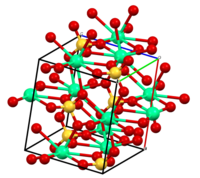
Photo from wikipedia
Abstract The sulfate resistance of both plain and nanosilica-blended cement mortars partially immersed in 5% Na2SO4 solution was investigated in this study. Before sulfate attack testing, the pore structure of… Click to show full abstract
Abstract The sulfate resistance of both plain and nanosilica-blended cement mortars partially immersed in 5% Na2SO4 solution was investigated in this study. Before sulfate attack testing, the pore structure of the samples was evaluated using mercury intrusion porosimetry. The mass loss, linear expansion and strength loss of the specimens were evaluated to characterise their damage progress. The microstructure and phase composition of the deteriorated samples were analysed using scanning electron microscopy equipped with energy dispersive spectroscopy and X-ray diffraction. The results indicate that the incorporation of nanosilica refined the pores and reduced the pore connectivity, which led to the improved sulfate resistance of cement mortars under partial immersion condition. Moreover, the sulfate resistance of cement mortars under partial immersion condition increased as their nanosilica content increased (in the range of 0 to 5 wt.% replacement of cement weight). Coarse nanosilica, which featured the average particle size of 50 nm presented better potential for enhancing the sulfate resistance of the specimens compared with fine nanosilica (average particle size of 10 nm). The main mechanism for the damage to the evaporation zone of mortars partially exposed to sulfate environment was the chemical sulfate attack rather than salt crystallization.
Journal Title: Construction and Building Materials
Year Published: 2020
Link to full text (if available)
Share on Social Media: Sign Up to like & get
recommendations!